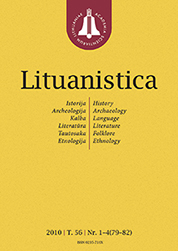LituanisticaWHAT?
 ISSN 0235-716X |
2005 m. Nr. 4 Lietuvos lenkų teritorinis pasiskirstymas ir skaičiaus kaita (1944 m. antrasis pusmetis – 1947 metai)
The article describes the territorial distribution of Lithuanian people of Polish descent, establishes their number and examines the factors that influenced the dynamics of the number of Poles in Lithuania. The majority of the Poles lived compactly in Vilnius and the counties of Vilnius, Trakai, and Ðvenèionys. At the end of 1944 – first half of 1945, 300–330 thousand Poles lived in Lithuania. Poles comprised the dominant ethnic group in the Vilnius region. Also, there were rather significant populations of Poles in the cities and countries of Alytus, Šiauliai, Panevëþys, Kaunas, Këdainiai, and Ukmergė. From the second half of 1944 through 1947, the principal factor that had a major influence on the Lithuanian Polish community was their repatriation to Poland, which occurred in accordance with an agreement signed in September 1944 by the government of the LSSR and the Polish Committee of National Liberation. During 1944–1947, more than 171 thousand people moved to Poland, out of around 380 thousand registered individuals according to official calculations. Actually, more people left (180–190 thousand, with Poles prevailing). Another factor that influenced the decrease of Poles in Lithuania was arrests, imprisonment, and deportations carried out by the NKVD-NKGB. During 1945–1951, about 15 thousand Poles in Lithuania were detained, arrested, deported, and imprisoned in various locations of the USSR. Mobilisation during 1944–1945 into the Polish army, which acted as part of the Red Army, also influenced the decline in the number of Poles. During 1944–1945, over 30 thousand Poles were recruited into it and the majority of them did not return to Lithuania. The principal factors that influenced the increase of the number of Poles in Lithuania were natural increase and migration from other republics of the USSR, especially Belarus. Migrants surged intensively into Lithuania during the first postwar years. One of the reasons for the intensive migration was Lithuania’s better economic–social situation. On the other hand, due to Polish repatriation back to Poland, the number of inhabitants in the Vilnius region declined markedly. This shortage was filled by arrivals from the USSR. Thus, the forced political and economic-social changes that began in Lithuania at the end of the Second World War and the changes of the border with Poland sharply affected the situation of Lithuanian Poles: Poles who lived in Vilnius and the Vilnius region during the Polish occupation in the interwar years and were the dominant ethnic group in the political sense remained dominant only in the region. Here they comprised a compact community with a large number of members. The other part of the community’s members were scattered all over Lithuania, with more Poles congregating in the counties of Alytus, Ukmergë, Kaunas, Panevëþys, Šiauliai, and Zarasai. Due to the repatriation agreement between the LSSR and Poland in the second half of 1944, Lithuanian Poles had to decide whether to stay in Lithuania or to move to Poland. During 1944–1947, 180–185 thousand people left Lithuania. Half of the repatriated Poles came from Vilnius. Repatriation had long-term consequences for both those Poles who remained in Lithuania and those who left: many families were broken since some of the members had left and had to leave beyond their homes and without the property they had earned; they had problems in adapting to living in a new area, etc., while the denationalisation of the Poles that remained in Lithuania occurred at a faster pace. After practically all the intelligentsia and the wealthy city inhabitants and farmers had left, the remaining Poles felt a cultural void and were inclined to self-isolation. These were the reasons for the weakening of the ethic identity. Repatriation had negative consequences for Lithuania’s demographic situation. With the emptying of Vilnius and the Vilnius region, the leadership of the USSR attempted to solve the problem of the lack of people through internal migration. But they were unsuccessful in realising the mobilisation plans. Therefore migration from the USSR influenced the ethnic demographic changes in the Vilnius region: arrivals from Russia, Belarus, Ukraine, Latvia and elsewhere took the place of the Poles who had left. Natural and mechanical growth had the greatest effect on the increase of the Polish community. During 1946–1948, the Polish community was augmented by fourteen thousand Poles from Belarus, Ukraine, and Russia. In addition, the number of Poles also increased due to assimilation processes. At the beginning of the 1950s, opportunities were created by the order of the Central Committee of the VKP(b) to expand the educational and cultural-social activities of Poles in the Vilnius region, which accelerated the Polonisation of the local inhabitants.
|
Numeriai:
2011 - T.57 Nr.1, Nr.2, Nr.3, Nr.4 2010 - T.56 Nr.1-4 2009 - T.55 Nr.1-2, Nr.3-4 2008 - T.54 Nr.1, Nr.2, Nr.3, Nr.4 2007 - T.53 Nr.1, Nr.2, Nr.3, Nr.4 2006 Nr.1, Nr.2, Nr.3, Nr.4 2005 Nr.1, Nr.2, Nr.3, Nr.4 2004 Nr.1, Nr.2, Nr.3, Nr.4 2003 Nr.1, Nr.2, Nr.3, Nr.4 2002 Nr.1, Nr.2, Nr.3, Nr.4 2001 Nr.1, Nr.2, Nr.3, Nr.4 |